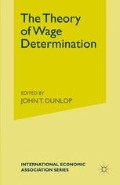Abstract
Economic theory provides a model of the operation of the labour market which helps to explain wage differentials and the allocation of labour between employers, occupations, industries, and regions as the market tends to move toward equilibrium. Marshall, for example, pointed to the ‘tendency’ of competition to result in ‘equality of efficiency-earnings in the same district’, and he added: 1
This tendency will be the stronger, the greater is the mobility of labour, the less strictly specialized it is, the more keenly parents are on the look-out for the most advantageous occupations for their children, the more rapidly they are able to adapt themselves to changes in economic conditions, and lastly the slower and the less violent these changes are.
Access this chapter
Tax calculation will be finalised at checkout
Purchases are for personal use only
Preview
Unable to display preview. Download preview PDF.
Notes
J. E. Cairnes, Some Leading Principles of Political Economy (1874), p. 72.
Gladys L. Palmer and Acta M. Stoflet, The Labor Force of the Philadelphia Radio Industry in 1936; Helen Herrmann, Teh Years of Work Experience of Philadelphia Weavers and Loomfixers (all WPA National Research Project reports done in co-operation with the Industrial Research Department, University of Pennsylvania, Philadelphia, 1938);
Herbert G. Heneman, Jr., ‘Differential Short-Run Labor Mobilities’ (1941–1942), in Minnesota Manpower Mobilities (October 1950);
Lloyd G. Reynolds, The Structure of Labor Markets (1951);
Charles A. Myers and W. Rupert Maclaurin, The Movement of Factory Workers (1943);
Charles A. Myers and George P. Shultz, The Dynamics of a Labor Market (1951);
Richard A. Lester, Hiring Practices and Labor Competition (1954).
Gladys L. Palmer, Labor Mobility in Six Cities: A Report on the Survey of Patterns and Factors in Labor Mobility, 1940–1950 (June 1954).
For an interpretative summary, see George P. Shultz, ‘Recent Research on Labor Mobility’, Proceedings of the Fourth Annual Meeting of the Industrial Relations Research Association (December 28–29, 1951), pp. 110–118.
A longer analysis of mobility studies will be found in the report by Herbert S. Parnes, Research on Labor, Mobility: An Appraisal of Research Findings in the United States, Bulletin 65, Social Science Research Council (September 1954). Essays on the significance of some of the local labour market studies, written by members of the Committee on Labor Market Research, are found in Labor Mobility and Economic Opportunity (1954).
Palmer, Labor Mobility, appendix, tables 15 and 18. A special study in San Francisco showed that the professional and technical group was relatively ‘closed’, i.e. there was not much movement into or out of the group during the decade. This was also borne out in a study of the lifetime work histories of 935 male heads of families in Oakland, California. Professionals had been in their present occupational group 80 per cent of their working lives. In contrast, more than a third of the persons who owned their own businesses (included in the managers, officials, and proprietors group) came from manual occupations. Seymour M. Lipset and Reinhard Bendix, ‘Social Mobility and Occupational Career Patterns’, American Journal of Sociology (January–March 1952), pp. 369–370 and 496–497.
Gertrude Bancroft, ‘Trends in the Labor Force’, Manpower in the United States, William Haber et al ed. (1954), pp. 138, 139.
I am indebted to Dr. Gladys L. Palmer of the University of Pennsylvania for this information. The studies are: (1) Rudolph Meidner, Svensk arbetsmarknad vid vull sysselsattning (The Swedish Labor Market at Full Employment), Konjunkturinstitutet, Stockholm, 1954; (2) L’Enqué pour sondage sur l’emploi, Institut National de la Statistique et des études Economiques, Paris; (3) Geoffrey Thomas, Labour Mobility in Great Britain, 1945–1949, London, The Social Survey (mimeographed).
Author information
Authors and Affiliations
Editor information
Copyright information
© 1957 International Economic Association
About this chapter
Cite this chapter
Myers, C.A. (1957). Labour Market Theory and Empirical Research. In: Dunlop, J.T. (eds) The Theory of Wage Determination. International Economic Association Series. Palgrave Macmillan, London. https://doi.org/10.1007/978-1-349-15205-6_20
Download citation
DOI: https://doi.org/10.1007/978-1-349-15205-6_20
Publisher Name: Palgrave Macmillan, London
Print ISBN: 978-1-349-15207-0
Online ISBN: 978-1-349-15205-6
eBook Packages: Palgrave Economics & Finance CollectionEconomics and Finance (R0)

